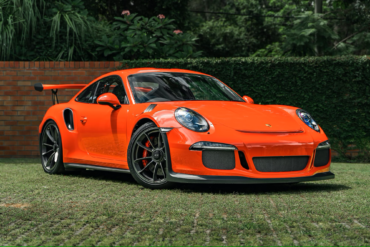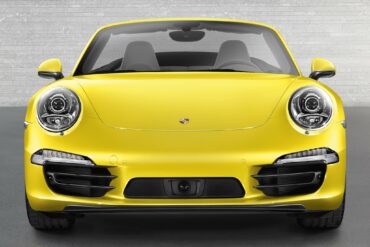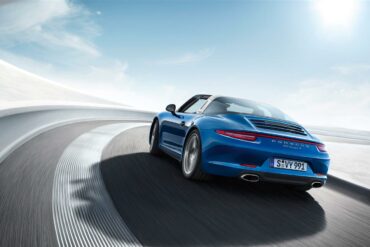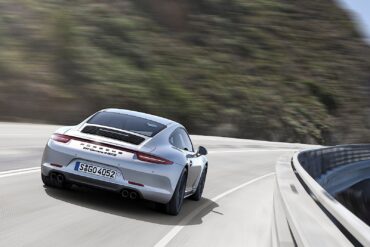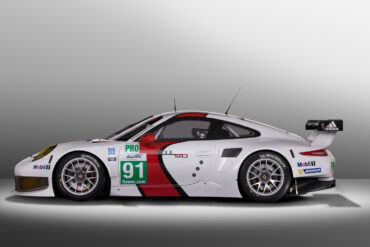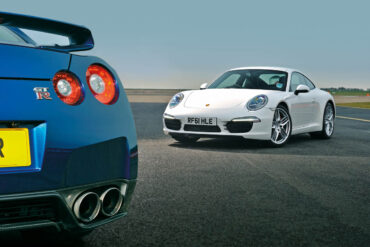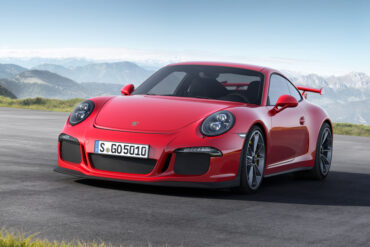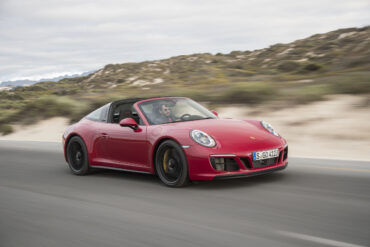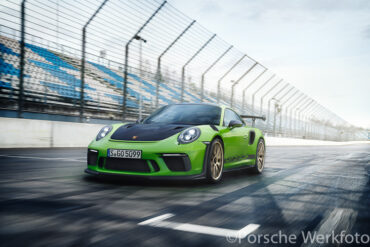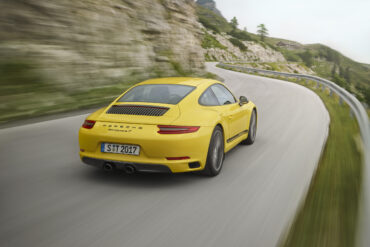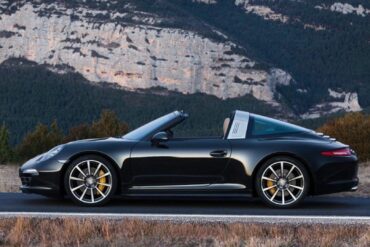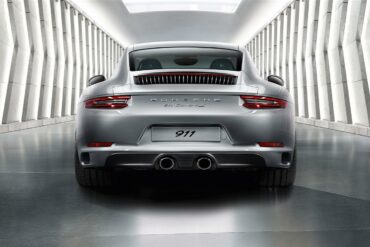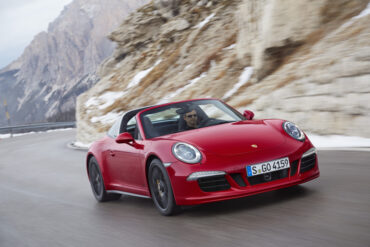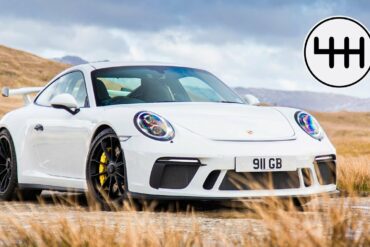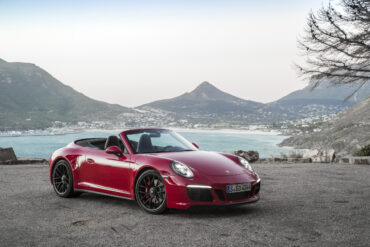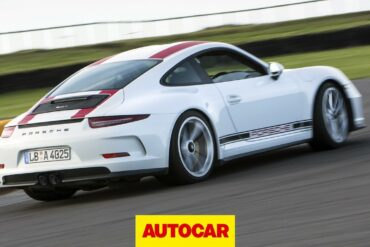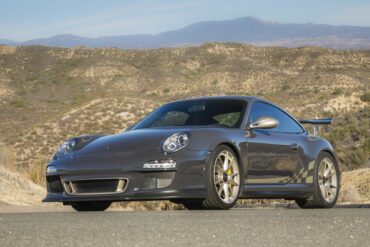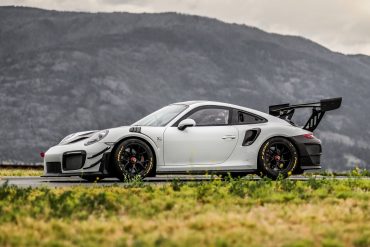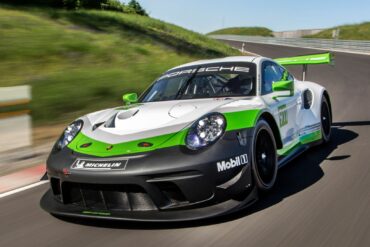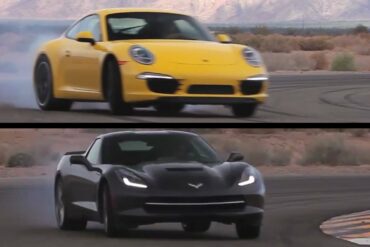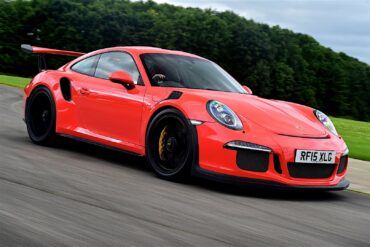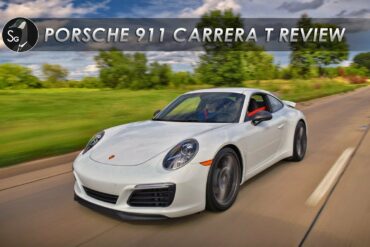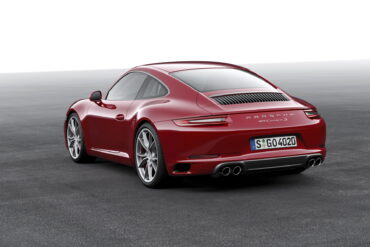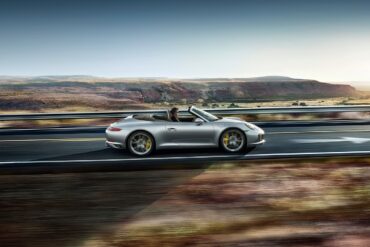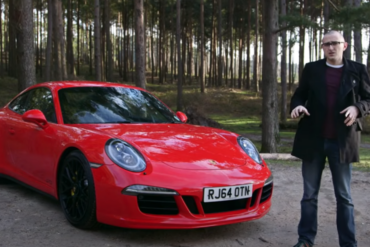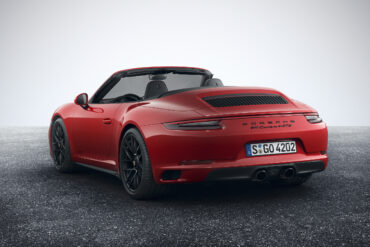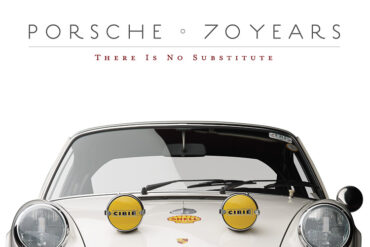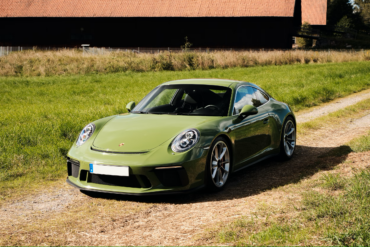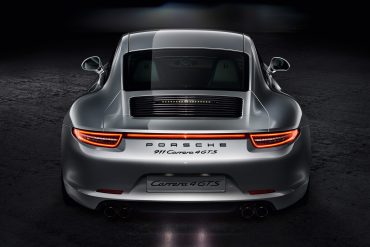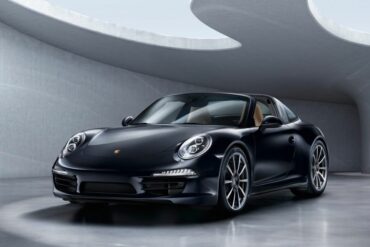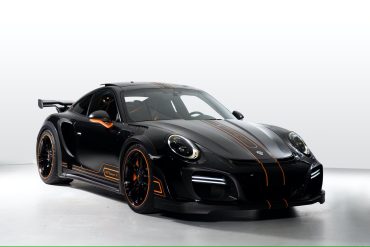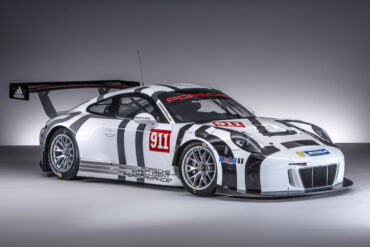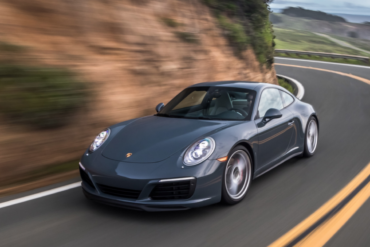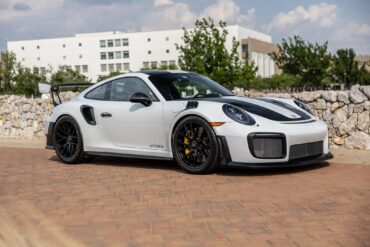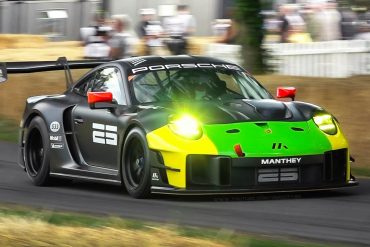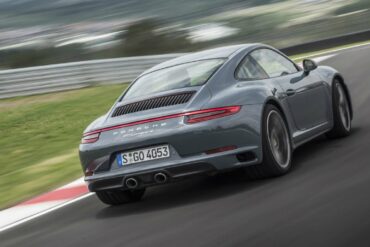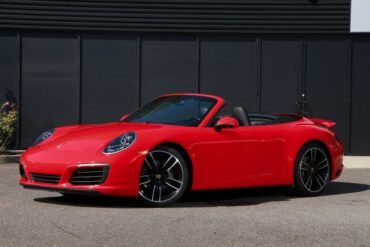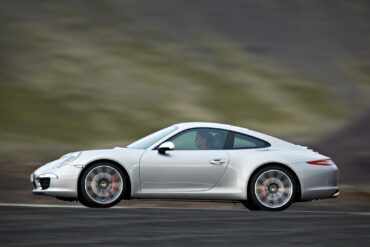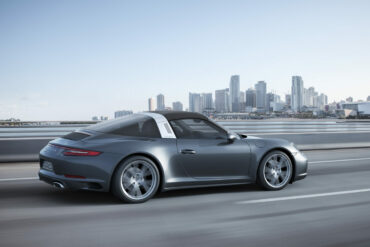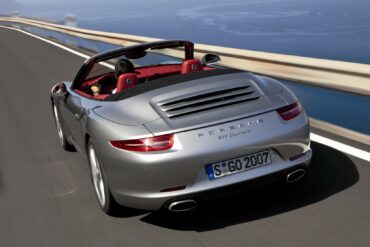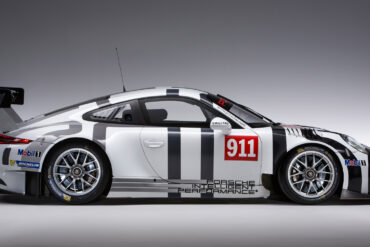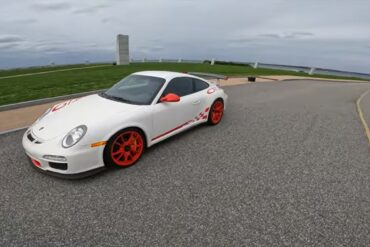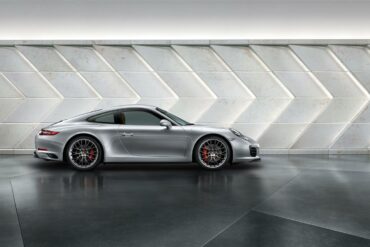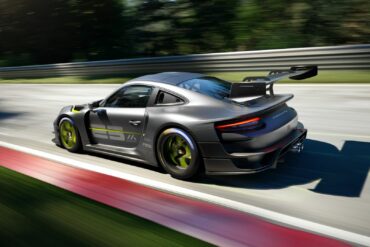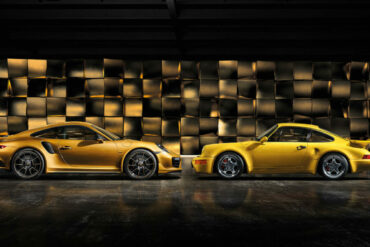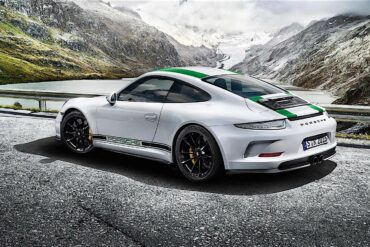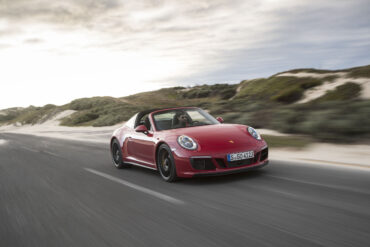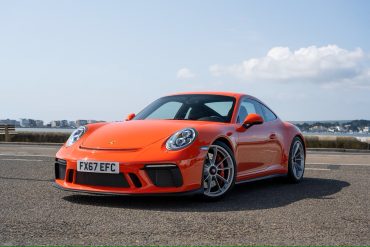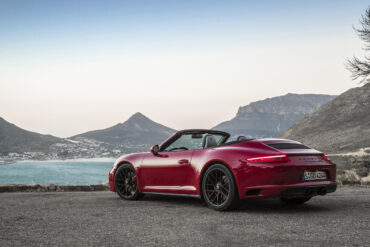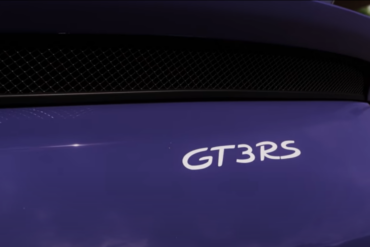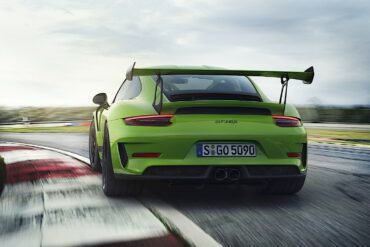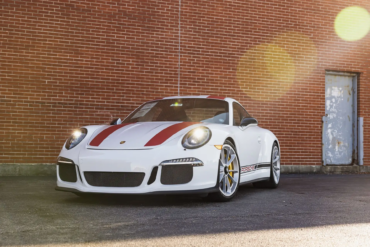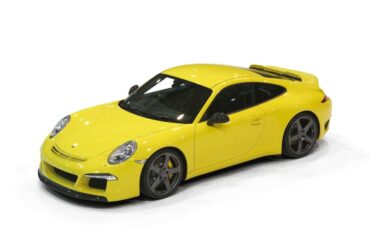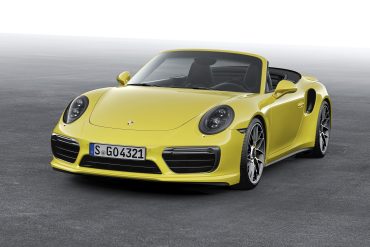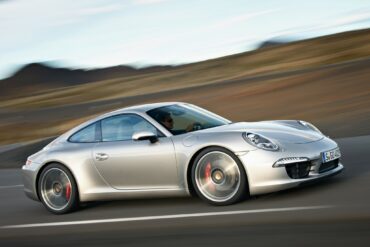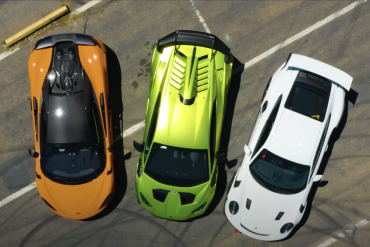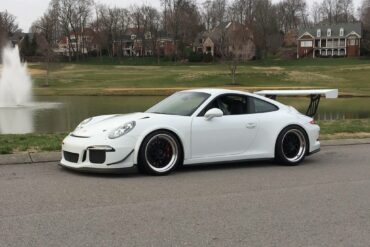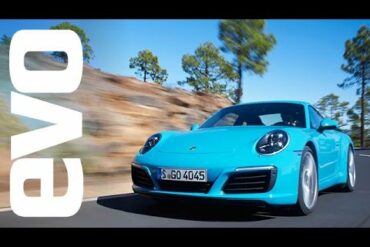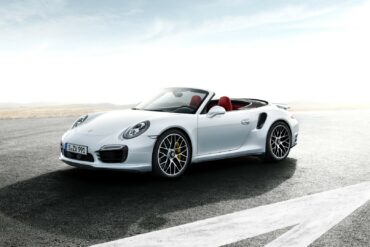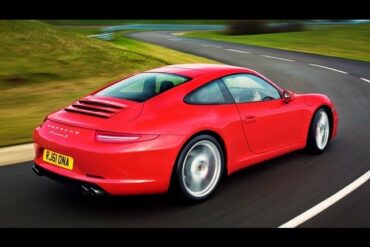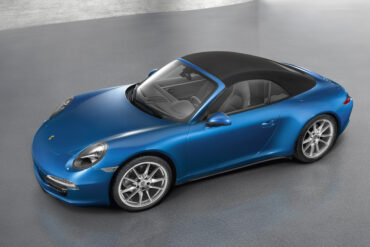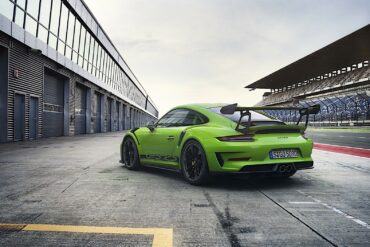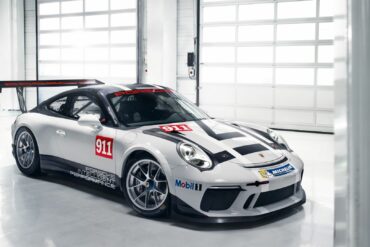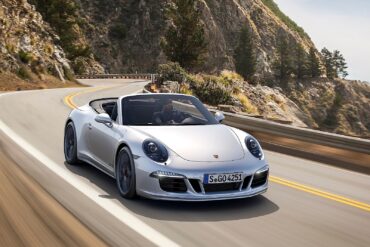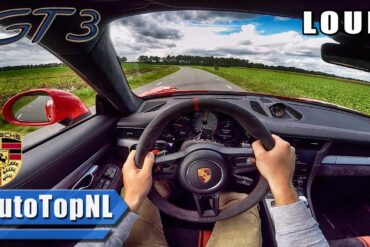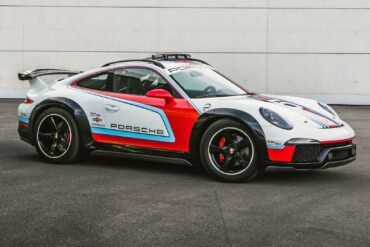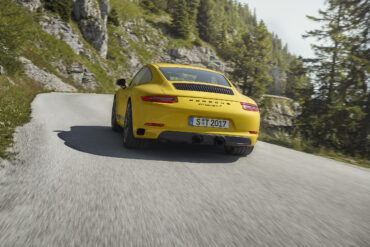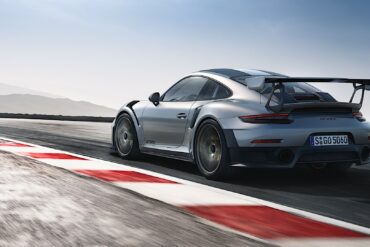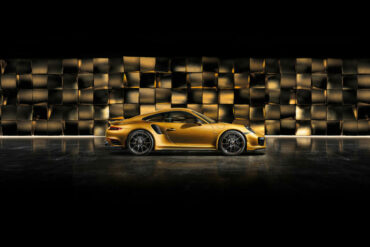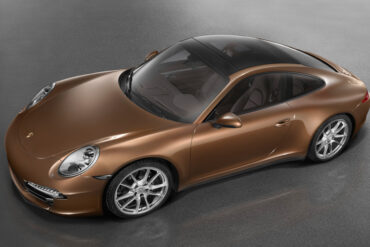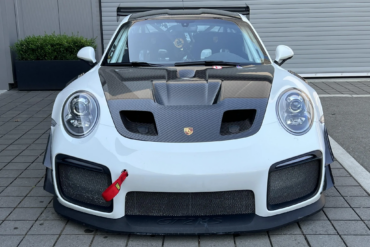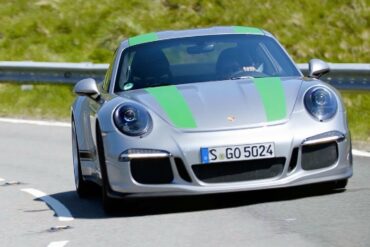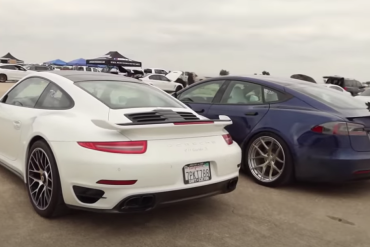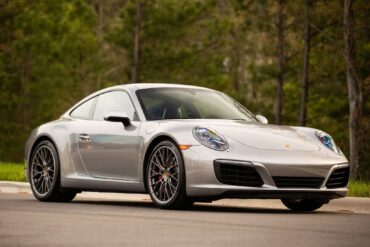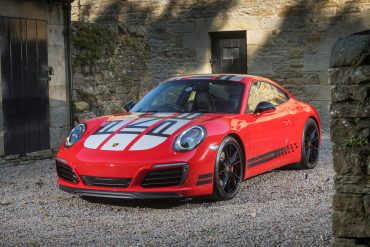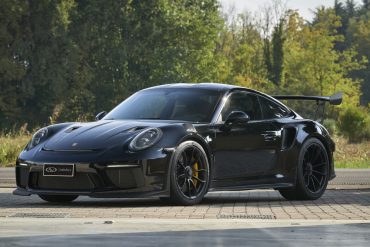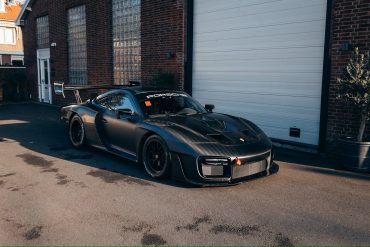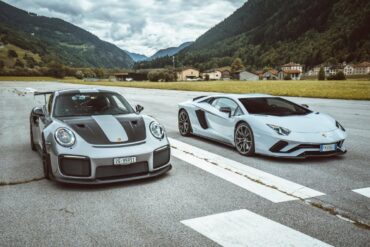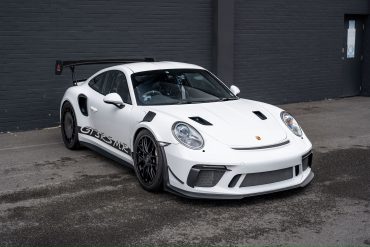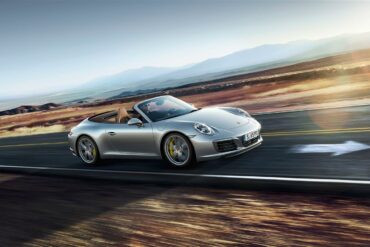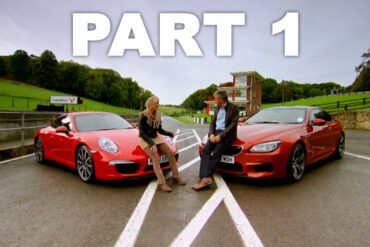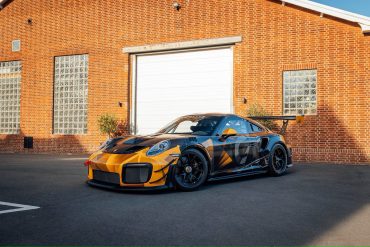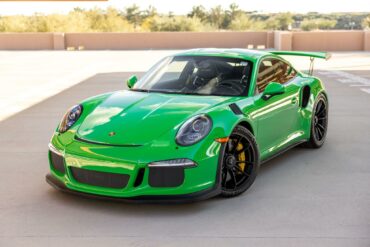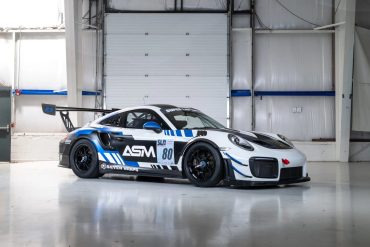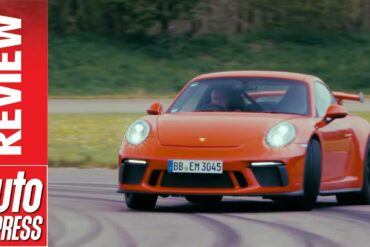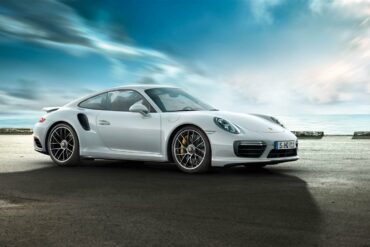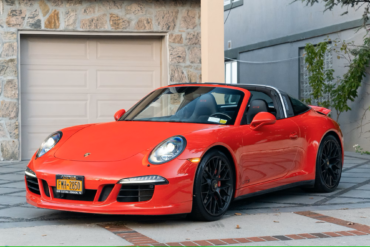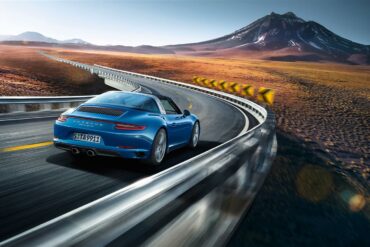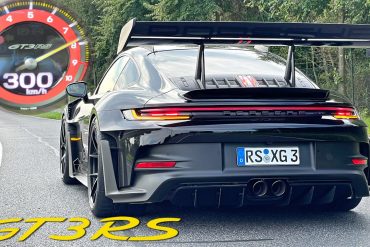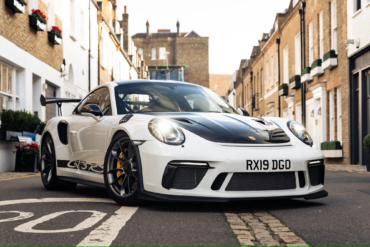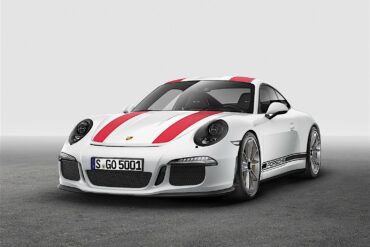Don’t miss your chance to own a low mileage and almost-new example of a 2016 Porsche 911 (991.1) GT3 RS...
2014 Porsche 911 Carrera 4S Cabriolet (991) Technical Specifications Engine Type Flat 6 Induction Normally-aspirated Cooling Water-cooled Valvetrain Four overhead camshafts,...
2015 Porsche 911 Targa 4 (991) Technical Specifications Engine layout Rear engine Engine type 6-cylinder boxer engine Cylinders 6 Valves per...
2015 – 2016 Porsche 911 Carrera 4 GTS (991) Pictures & Gallery ...
Porsche 911 RSR (991) (2013-2016) – Pictures & Gallery...
Nissan GT-R vs Porsche 911 Carrera S evo’s latest signing, Tiff Needell, puts the 2012 Nissan GT-R and the brand...
Porsche introduced the 991 GT3 for the 2014 model year, as follow up to the multiple 997 GT3 variants. The 991 GT3 featured a new 3.8 litre direct fuel injection (DFI) flat-six engine developing 475 hp (354 kW; 482 PS) at 8,250 rpm, Porsche's Doppelkupplung (PDK) double-clutch gearbox, and rear-wheel steering. The 911 GT3 is claimed to be able to accelerate from 0-60 mph (97 km/h) in 3.1 seconds or less, and the quarter mile in 11.2 seconds at 126 mph (203 km/h). It evolved into the 991.2 GT3 for model year 2018.
2019 Porsche 911 Targa 4 GTS (991.2) Technical Specifications Engine Engine layout Rear Engine Engine type Boxer, twin-turbo Cylinders 6 Valves...
2018 Porsche 911 GT3 RS With a clear focus on motorsport, the Porsche Motorsport department will present its latest project...
2018 Porsche 911 Carrera T (991.2) Technical Specifications Make Porsche Model 911 Carrera Generation 2018 – Present Sub-Model Touring (T) Car...
2014 Porsche 911 Targa 4S (991) Technical Specifications Engine layout Rear engine Engine type 6-cylinder boxer engine Cylinders 6 Valves per...
2019 Porsche 911 Carrera S Coupe (991.2) Technical Specifications Engine Engine layout Rear Engine Engine type Boxer, twin-turbo Cylinders 6 Valves...
Here we have a battle between two German sports cars: a 991.2-generation Porsche 911 Turbo S with a whooping 900...
The Targa 4 GTS gets Porsche’s a powerful non-turbo rear-mounted flat-six engine with 430 bhp @ 7500 rpm and 325 ft lbs of torque from 5750 rpm, driven to all four wheels via Porsche Traction Management. Performance is also enhanced via the standard Sport Chrono package, which provides faster throttle response and more aggressive shift mapping. In addition, the GTS benefits from Porsche Active Suspension Management - Porsche’s proprietary adaptive suspension system with continuously variable dampers. Mechanically, this is the perfect package for a daily 911 that is also performance focused when you need it to be.
Carfection Makes The Case for the Manual Henry Catchpole demonstrates why the manual is something to be treasured in a...
Porsche really has hit its brief with the turbocharged Carrera GTS Cabriolet. It is hugely capable on the road, easy to live with on a daily basis, and come the weekend, it’s massively fast on track. For the money, and for drivers who really want just a little more 911, but without the mind-bending speed of a Turbo or uncompromising nature of a GT3, then this is the car for you. It also looks unique and has enough of its own style that it it feels special both on the outside and inside.
The Porsche 911 R On Track The phenomenal Porsche 911 R stars in our penultimate video from Britain’s Best Driver’s...
The 911 GT2 RS Clubsport made its debut alongside the new 992-generation 911 at the 2018 Los Angeles Auto Show,...
The GT3 R has always been placed between the GT3 Cup and the very expensive RSR. All the 991.2 racing cars have normally aspirated 4-litre engines. Compared to the 991.1 GT3 R, the 991.2 GT3 R engine offers a broader usable rev range and the engine response is more precise due to 6 throttle butterflies. The roof, front hood and fairing, wheel arches, doors, side and tail sections, rear lid and interior trim are made of carbon-fibre reinforced plastic. Gets new double wishbone suspension.
Chris Harris Compares the Corvette C7 v Porsche 991 Carrera S. On Track The Corvette costs the same as the optional...
For those who want more extreme performance, handling and track-day bragging rights, the RS is it. It's far from practical and may be too extreme for some, especially on the street, but on track it is exceptional. Only marginally quicker than the 991 GT3 that it is based on, but it delivers that performance with a different character. Massive grip, massive downforce and more extreme than the GT3. It delivers 80 per cent of the downforce of the full-on GT3 R race car, and with a carbon fibre bonnet and wings, a magnesium roof and polycarbonate rear windows and screen, it’s also light, weighing in at just 1,420kg.
Porsche 911 Carrera T In Depth We review the last model year of the 991.2 Porsche 911 Carrera T. The...
Porsche Option Codes – Porsche 911 (2016 Model Year) Looking to decode your 2016 Porsche 911 option codes? Want to...
2016 Porsche 911 Carrera S Cabriolet (991.2) Technical Specifications Engine Engine layout Rear Engine Engine type Boxer, twin-turbo Cylinders 6 Valves...
991 911 Carrera GTS Review The Porsche 911 Carrera GTS (991) stretches what the original GTS stood for but in real...
2018 Porsche 911 Carrera 4 GTS Cabriolet (991.2) Technical Specifications Engine Engine layout Rear Engine Engine type Boxer, twin-turbo Cylinders 6...
Porsche 70 Years – There Is No Substitute: by Randy Leffingwell © Quarto Publishing It’s a heavyweight book, landscape in...
Porsche has unveiled the 991-generation 911 GT3 with Touring Package at the 67th International Motor Show in Frankfurt. The car...
2015 Porsche 911 Carrera 4 GTS (991) Technical Specifications Engine layout Rear Engine Engine type Boxer-6 Cylinders 6 Valves per...
2015 Porsche 911 Targa 4S (991) Technical Specifications Engine layout Rear engine Engine type 6-cylinder boxer engine Cylinders 6 Valves per...
TechArt has transformed this 991.2-generation 911 Turbo S into their high-performance ‘GTStreet R’ specification. The car is coated in a...
2016 – 2018 Porsche 911 GT3 R (991.1) Pictures & Gallery...
The new downsized flat-six gets forced induction, more power and greater efficiency, just like in the basic refreshed 911 Carrera, this time mated to a four-wheel-drive system nicked wholesale from the Turbo. Apparently one in three 911 buyers opt for a four-wheel-drive variant, so this is an important car to get right. The 3.0-liter twin-turbo flat-six in the 911 Carrera 4S is good for 414hp and 368 ft lbs of torque, helping it get from 0 to 62 mph in 4.2 sec with a manual, 4.0 seconds with the PDK and 3.6 sec with the PDK and optional Sport Chrono pack.
The debut of the Porsche 911 GT2 RS took place during the 997 generation in 2010 and received exceptional acclaim....
Watch this video by 19Bozzy92 YouTube channel featuring a Porsche 911 GT2 RS Clubsport 25, a special limited edition model...
2016 Porsche 911 Carrera 4 Coupe (991.2) Technical Specifications Engine layout Rear Engine Engine type Boxer, twin-turbo Cylinders 6 Valves per...
Head to Head Mercedes-AMG GT C vs Porsche 911 Carrera T For the road, the GT C is the best...
2019 Porsche 911 Carrera 4 Cabriolet (991.2) Technical Specifications Engine layout Rear Engine Engine type Boxer, twin-turbo Cylinders 6 Valves per...
2014 Porsche 911 Carrera S Coupe (991) Technical Specifications Engine Type Flat 6 Induction Normally-aspirated Cooling Water-cooled Valvetrain Four overhead camshafts,...
Henry Catchpole drives the 991.2 Porsche 911 GT3 RS in search of the forgotten Sudschleife circuit....
2018 Porsche 911 Targa 4 (991.2) Technical Specifications Engine Engine layout Rear Engine Engine type Boxer, twin-turbo Cylinders 6 Valves per...
2012 – 2015 Porsche 911 Carrera Cabriolet Pictures & Gallery...
(2016-2018) Porsche 911 GT3 Cup (991.1) Technical Specifications Powering the new 911 GT3 R is a cutting-edge four-litre flat-six unit...
Vehicle Virgins just released a review on the manual Porsche 911 GT3 RS. Make sure to listen to the last...
Ultimate Track Test Introducing the ULTIMATE 911 – the Porsche 911 GT2 RS! When it comes to road-going sports cars,...
2016 Porsche 911 Carrera S Coupe (991.2) Technical Specifications Engine Engine layout Rear Engine Engine type Boxer, twin-turbo Cylinders 6 Valves...
2021 Porsche 911 GT2 RS Clubsport 25 (991.2) Technical Specifications What drives us? The next victory. Even after 25 years,...
2019 Porsche 911 Turbo S Exclusive (991.2) Technical Specifications Engine Engine layout Rear Engine Engine type Boxer, twin-turbo Cylinders 6 Valves...
2016 Porsche 911 R (991) Technical Specifications Engine layout Rear Engine Engine type Boxer Cylinders 6 Valves per cylinder 4 Construction...
2017 – 2019 Porsche 911 Targa 4 GTS (991.2) Pictures & Gallery...
The 991.2-generation 911 GT3 Touring was created as a more subdued option compared to its track-focused counterpart. It swaps out...
2017 Porsche 911 Carrera GTS Cabriolet (991.2) Technical Specifications Engine Engine layout Rear Engine Engine type Boxer, twin-turbo Cylinders 6 Valves...
991.1 Porsche 911 GT3 RS Review Evo’s Henry Catchpole delivers his first impressions on the incredible new 991.1 Porsche 911...
2019 Porsche 911 GT3 RS (991.2) Technical Specifications Engine Engine Type Aluminium horizontally opposed and naturally aspirated engine Displacement 3996 cm3...
Despite its limited numbers, the 2016 Porsche 911 R instantly become a hit among the most avid Porsche collectors and...
2014 RUF RCT RUF’s turbocharged cars have a proven track record, sustained over 37 years at the cutting edge of...
2019 Porsche 911 Turbo S Cabriolet (991.2) Technical Specifications Engine Engine layout Rear Engine Engine type Boxer, twin-turbo Cylinders 6 Valves...
2012 – 2015 Porsche 911 Carrera S Pictures & Gallery...
McLaren 600LT vs Lamborghini Huracan STO vs Porsche GT3 RS This is actually a pretty fair comparison video. For those...
This 2014 Porsche 911 GT3 has been transformed into a street-legal track monster with genuine bodywork from Porsche Motorsports North...
Does turbocharging dull the tone of its 3-litre flat-six? Henry Catchpole provides us with a first glimpse of the second-gen...
2016 Porsche 911 Targa 4 (991.2) Technical Specifications Engine Engine layout Rear Engine Engine type Boxer, twin-turbo Cylinders 6 Valves per...
2014 – 2016 Porsche 911 Turbo S Cabriolet (991) Pictures & Gallery ...
Autocar Reviews the New 991.1 Carrera S The new Porsche 911 Carrera S (991) is the most important new sports...
2013 – 2015 Porsche 911 Carrera 4 Cabriolet Pictures & Gallery ...
2018 Porsche 911 GT3 RS (991.2) Technical Specifications Engine Engine Type Aluminium horizontally opposed and naturally aspirated engine Displacement 3996 cm3...
2016 – 2020 Porsche 911 GT3 Cup (991.2) Pictures & Gallery...
So what else do you get when you buy a 991 Carrera 4 GTS Cabriolet? First of all you get a 30 hp bump over the Carrera 4S to 430 hp from the 3.8L naturally aspirated flat-six. You get forged centre-lock black 20-inch wheels, dynamic engine mounts, the Sports Chrono Package, PASM adaptive damping with a lowered ride height, an interior swathed in Alcantara, a sinister front fascia with black intakes and custom rear apron with black tailpipes that broadcast the goods through an uber-nasty sport exhaust system. Other trim details include black lettering and smoked headlights.
991.2 911 GT3 POV Driving Impressions Porsche 911 GT3 (991.2) POV Test Drive INSANE SOUND!! by AutoTopNL...
The Porsche 911 Vision Safari a sports car-based rally car concept, designed and built by Porsche in 2012, based on the Porsche 911 (generation 991) and harkening back to the original car, the Porsche 911 SC Safari from 1978. Features a raised suspension, reinforced wheel housings and large bumpers.
2018 – 2019 Porsche 911 Carrera T (991.2) Pictures & Gallery...
2018 Porsche 911 GT2 RS (991.2) Technical Specifications Body type Coupe Seats 2 Doors 2 Powertrain Architecture Internal Combustion engine...
2018 – 2019 Porsche 911 Turbo S Exclusive (991.2) Pictures & Gallery ...
The 2013 Porsche Carrera 4 featured a 3.4-liter flat-six engine. It was mated as standard to a world's first seven-speed manual transmission. An automatic, PDK (dual-clutch) transmission was offered as an option. The Carrera 4 featured an all-wheel-drive torque distribution in the instrument cluster display. The most distinctive identifying feature of the 911 with all-wheel drive is still the wide rear section: compared to the two-wheel drive 911 Carrera models, the rear wheel housings 22 mm wider, and each of the rear tires is 10 mm wider.
2019 was the last model year for the seventh-generation 911 (991) and for that Porsche introduced the GT2 RS Clubsport....
The Porsche 911 GTS (991.1) Review Jason continues his quest to find the best modern Porsche 911 for all occasions....
Real Rivals. Which Is Better? We test the brand new 2015 Audi R8 V10 Plus against the 991 Porsche 911...
Drivers Cars & What Makes Them So Special Chris Harris compares and contrasts the Porsche 911R and the Peugeot 205...
I know these drag races are kind of pointless to most of us, but I do think they are entertaining....
If you head over to PCarMarket now, you’ll find a gorgeous and low mileage example of a 2017 Porsche 911...
Designed and manufactured by Porsche Exclusive, also known as the ‘Special Wishes Department’, this department of the factory is dedicated...
When automotive enthusiasts are asked to describe the pinnacle of the Porsche 911, the GT3 RS overwhelmingly dominates the conversation....
The latest version of the Porsche 935 made its official debut in the fall of 2018 at the Laguna Seca...
Porsche GT2 RS vs Lamborghini Aventador S! The title says it all. Just two friends drag racing two amazing cars...
2019 Porsche 911 Carrera 4 Coupe (991.2) Technical Specifications Engine layout Rear Engine Engine type Boxer, twin-turbo Cylinders 6 Valves per...
Offered for sale via auction on Collecting Cars a sensational track-focused performance car, upgraded by legendary Porsche specialist Manthey Racing...
2017 Porsche 911 Carrera S Cabriolet (991.2) Technical Specifications Engine Engine layout Rear Engine Engine type Boxer, twin-turbo Cylinders 6 Valves...
Fifth Gear Pits The Porsche 911 Carrera S vs BMW M6 Sabine Schmitz joins Tiff in seeing which car is...
Debuting alongside the 992-generation 911 at the 2018 Los Angeles Auto Show, the 911 GT2 RS Clubsport represented the pinnacle...
The 2019 model year marked the end of seventh-generation 911 production. To commemorate this, Porsche introduced the GT2 RS Clubsport...
The Porsche 991 GT3 RS is a track-focused variant that was unveiled at the 2015 Geneva Motor Show. It introduced...
Unveiled alongside the 992-generation 911 at the 2018 Los Angeles Auto Show, the 911 GT2 RS Clubsport marked the culmination...
New Porsche 911 GT3 2017 Thorough review of the 991.2 Porsche 991 GT3. As well as being the fastest and...
With the Turbo S, the PDCC Porsche Dynamic Chassis Control hydraulic roll bars came as standard. The PCCB Porsche Ceramic Composite Brakes had been standard on the Turbo S already since the 996 generation. New options included the radar-based lane change assist and a lift system for the front axle (increased ground clearance by 1.6″/40 mm). The PCM now had a multi-touch screen like in the facelifted 991 Carrera. Routes and places could be visualized with 360-degree images and satellite images. Engine gets more horsepower too, now with 572 bhp and 553 ft lbs of torque.
When it was first introduced, many people were skeptical about the need for the Targa 4 GTS especially that it...
2017 Porsche 911 Targa 4S (991.2) Technical Specifications Engine Engine layout Rear Engine Engine type Boxer, twin-turbo Cylinders 6 Valves per...
Although the 911 GT3 RS wasn’t engineered for top speed, it demonstrates impressive straight-line performance. Powered by a naturally aspirated...
This 2019 Porsche 911 (991.2) GT3 RS is a highly acclaimed performance car designed for track use, and it comes...
2016 Porsche 911 R (991) Pictures & Gallery ...


